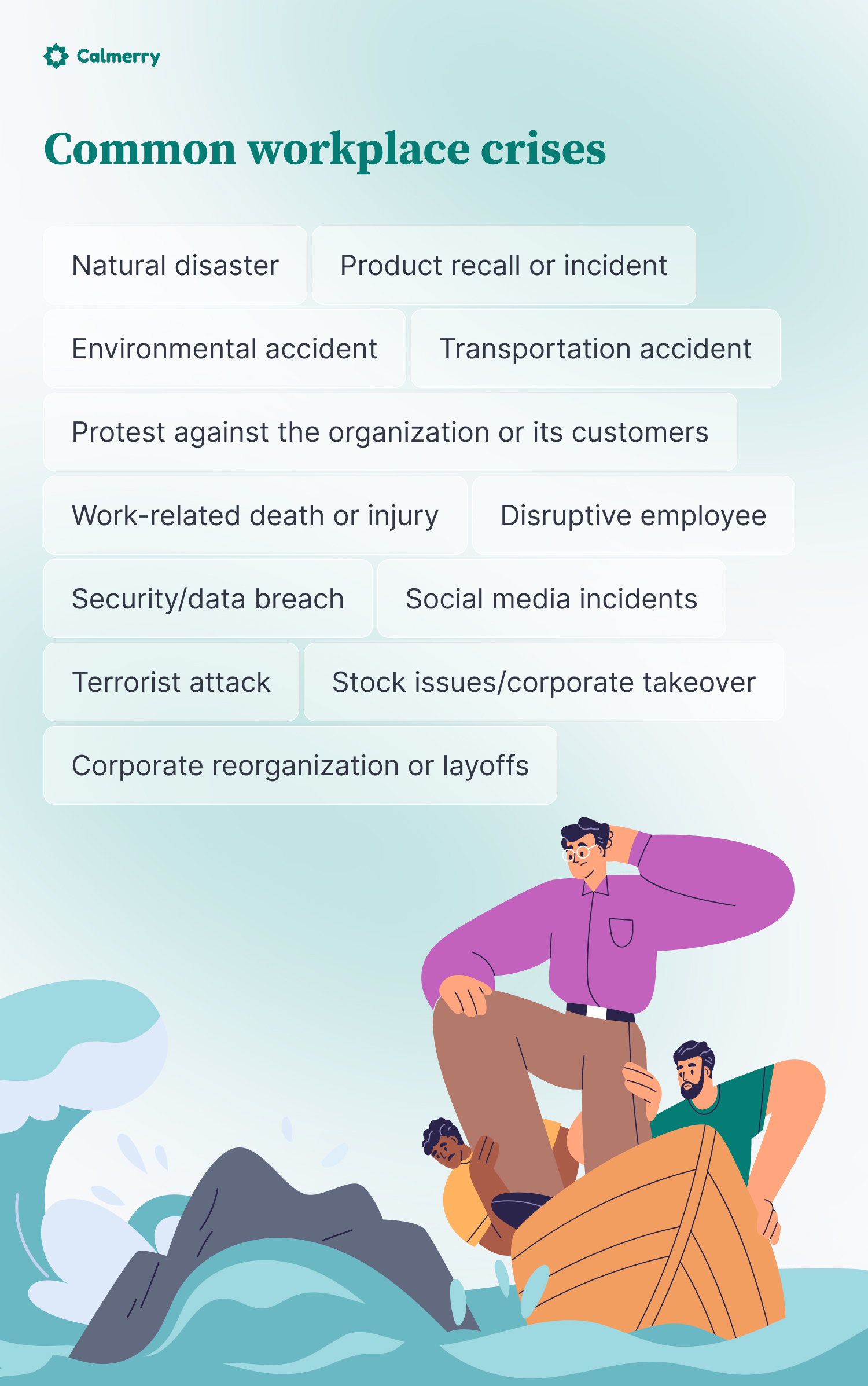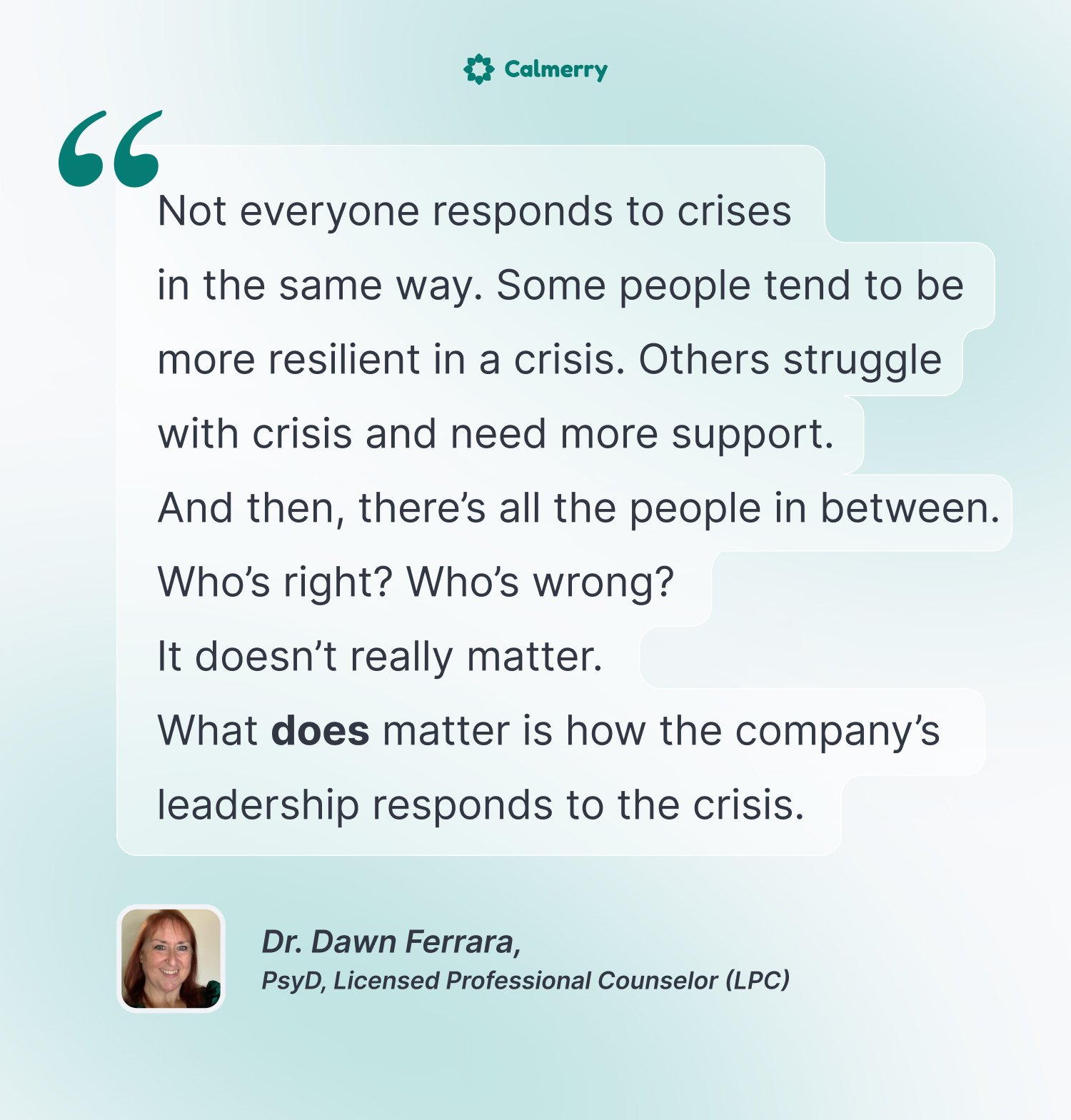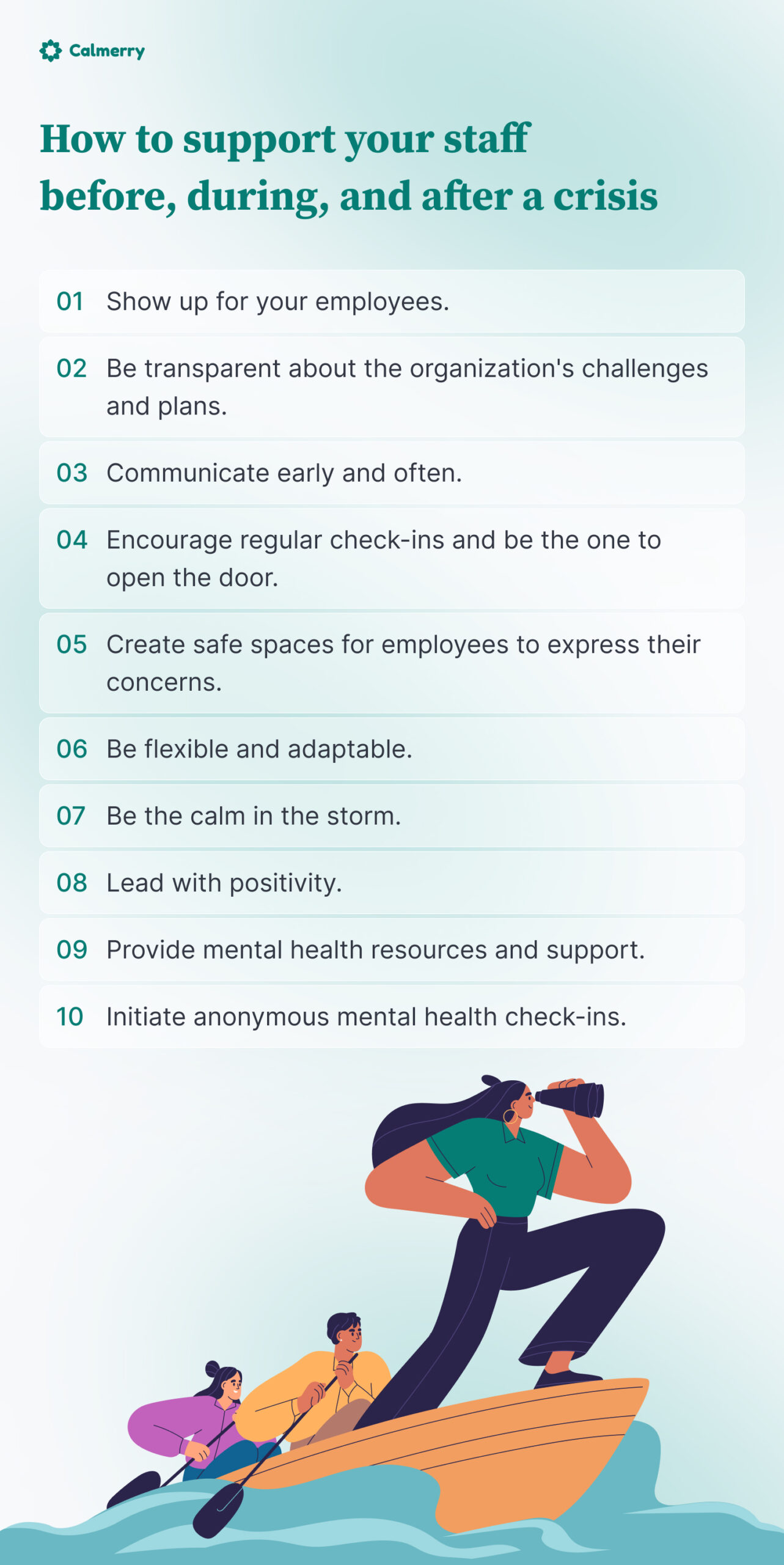How Can You Support Staff During and After a Crisis?

In this article
Change is a part of every aspect of life. It’s what keeps everything in life moving forward.
Still, change is hard. It’s sometimes unexpected and often scary. While change is necessary, not knowing what’s next can leave you feeling anxious and apprehensive. Even angry that things can’t remain the same.
The workplace is no different. The work environment is constantly changing. Every day brings something new.
Some changes are subtle and are seamlessly assimilated into the workplace. Other changes are sudden, unexpected, and sometimes even disruptive.
A business may even find itself facing a crisis.
What is a crisis in a business environment?
Crisis. That word might surprise you.
In the context of a business environment, a crisis is any situation or event that has the potential to cause sudden and serious damage to a company’s employees, its reputation, or financial standing. [1] Firestone, S. (2020). What is crisis leadership? In Springer eBooks (pp. 7–21). https://doi.org/10.1007/978-3-030-44955-1_2
Crises happen quickly, often without warning, and pose significant risks to the company. The organization is forced to take quick action to mitigate the possible consequences.
Examples of crisis in a company
Just what constitutes a crisis can vary.
Common workplace crises can include: [1] Firestone, S. (2020). What is crisis leadership? In Springer eBooks (pp. 7–21). https://doi.org/10.1007/978-3-030-44955-1_2
- Natural disaster
- Product recall or incident
- Environmental accident
- Transportation accident
- Protest against the organization or its customers
- Work-related death or injury
- Disruptive employee
- Security/data breach
- Social media incidents
- Terrorist attack
- Stock issues/corporate takeover
- Corporate reorganization or layoffs
One of the more recent and recognizable workplace crises was the pandemic. Seemingly overnight, companies had to shift priorities and resources to keep their businesses running, maintain employee safety, and comply with unprecedented restrictions.
Everyone got an overnight lesson in crisis response. Companies that led from the front seemed to fare better than those who simply managed crisis or, worse, tried to hold the status quo.
– Dr. Dawn Ferrara, PsyD, Licensed Professional Counselor (LPC), and mental health writer

Why it’s important to support your employees
There’s a human side to crisis. Companies are made up of people, and employees at every level will feel the impact in some way.
When it comes to a crisis, one thing is certain: big changes, even necessary ones, can shake an organization’s workforce to the core.
What the organization, its culture, and employee morale look like on the other side largely depends on how well a company is prepared and how quickly it can respond.
Managed poorly, the price is high. Managed well, your organization and your employees can come through the transition resilient, strong, and united in the company’s vision moving forward.
Understanding the psychology of change
To understand how to help your employees navigate a workplace crisis, it’s important to understand why it can be so hard.
For most people, work is more than just a job. A person’s identity is closely tied to their roles, their beliefs, perceptions, values, and more.
While the person is not their job, that role does hold meaning and importance for many. When something threatens that role, it’s perceived as a threat and defenses go up.
– Dr. Dawn Ferrara, PsyD, Licensed Professional Counselor (LPC), and mental health writer
Big changes, like crises, are disruptive. People like routine and find comfort and satisfaction in what’s predictable. When that turns upside down, the first response is to try to regain stability and familiarity.
They may be resistant to or minimize what has happened. Others may be less distressed or more accepting of the situation.
When faced with a crisis, expect that your employees will struggle, at least in the early days, and may respond in unexpected ways.
Not everyone responds to crises in the same way. Some people tend to be more resilient in a crisis. Others struggle with crisis and need more support. And then, there’s all the people in between.

It doesn’t mean one kind of employee is in any way better than another. It simply means that while employees are a group, they are also quite individual. What’s happening will hold a different meaning for each of them.
They may be united in some respects and far apart in others. Some may perceive even a sudden change (e.g., a reorganization) as an opportunity for growth, while others may see it as a worst-case scenario.
Who’s right? Who’s wrong? It doesn’t really matter.
What does matter is how the company’s leadership responds to the crisis. Employees tend to have a lot of emotional currency invested in their workplace and their colleagues.
They may not know what to do and will look to their leaders for guidance.
What is crisis leadership?
Crisis leadership is a term that has emerged in the business environment to describe a specific, proactive way of responding to a crisis using strategies that move the company and its employees through the process.
Crisis management, while often used interchangeably, is more reactive and short-term, focusing on the immediate aftermath.
Crisis leadership is an opportunity for a company to be proactive in its response to a crisis. This style of leadership anticipates and prepares the organization and its employees for the possibility of crisis.
Being prepared helps strengthen resilience and confidence.
How you can support your staff before, during, and after the crisis
What you do in the period before, during, and after the crisis will shape how well your employees fare.
Here’s how you can support and guide them through the crisis:

1. Show up for your employees
There’s an old saying that goes something like this: People may not remember exactly what you said, but they’ll always remember how you made them feel.
In a crisis, emotions are running hot. There will be questions and fears. An absent leader (even the perception of one) can leave them feeling abandoned.
Be visible and consistent. Staying present and connected with your employees can go a long way to creating a sense of trust and support, especially in a crisis.
Let them see you working alongside them. Make it easy to engage with you.
When your employees know you’re all in it together, you’re more likely to be able to maintain a cohesive team that is better able to navigate a crisis.
2. Be transparent about the organization’s challenges and plans
Transparency is the foundation of trust. When a crisis occurs (or is looming), you need the trust of your employees, and they will look to you for guidance.
They may not know every detail, but people have a good sense of when something shifts in their environment.
Honesty really is the best policy here. Provide reliable, credible information. If you don’t know something, it’s OK to say that. Resist the urge to gloss over or avoid the hard truths.
“Nothing to see here” won’t fly and will erode their trust in you.
Along with being transparent, let your team know what the plan is. You want to minimize speculation or misinformation. When everyone knows the plan, they can focus on their roles and keep things moving forward.
– Dr. Dawn Ferrara, PsyD, Licensed Professional Counselor (LPC), and mental health writer
3. Communicate early and often
You might think this goes without saying, but communication is often the first thing to break down in a crisis, sometimes without warning.
Take Hurricane Katrina, for example. An entire region was without cell, phone, and internet service for weeks (in some cases months). A lot of companies were not prepared and had to scramble to find and connect with their employees, many of whom were scattered across the country.
While that’s an extreme example, it’s illustrative of the impact a sudden crisis can have and the importance of having a plan for connecting.
Needless to say, disaster preparedness became a hot topic in the months and years following.
Communication is the key to keeping your employees connected and informed of what’s happening. You want them to have credible sources of information and not have to rely on outside spectators, the media, etc.
Let them know how you will be communicating with them and how often. Let them know how best to reach you if regular lines of communication are disrupted.
When your employees know that you are keeping them abreast of what’s happening., they can focus their attention on the task at hand. And their trust in your leadership remains strong.
– Dr. Dawn Ferrara, PsyD, Licensed Professional Counselor (LPC), and mental health writer
4. Encourage regular check-ins
This strategy goes hand-in-hand with communication. When things are moving at lightning speed, touching base becomes even more important. Everyone will be feeling the stress.
This is a great place to lead by example.
Make it a point to check in with your team and encourage others to do the same. Be visible.
You may think you have an open-door policy, but your staff may not feel like they can approach you in the middle of a crisis. Be the one to open the door. Invite the conversation.
You’ll foster connections and get a real sense of where everyone is. This knowledge can help you see needs early and rally support for those who might be needing it.
5. Create safe spaces for employees to express their concerns
Depending on the type of crisis, some employees may feel uncomfortable expressing their concerns openly. Create safe spaces for people to talk about their concerns without judgment or repercussions.
Not everyone will have the same view, and that’s OK.
Safe spaces give people a place to release their feelings, express concerns, and find information and support. While you may not always have answers, sometimes just having a place to “say it out loud” is healing and reassuring.
– Dr. Dawn Ferrara, PsyD, Licensed Professional Counselor (LPC), and mental health writer
Normalize talking about what is happening.
6. Be flexible and adaptable
A crisis situation is fluid and will likely take more than a few twists and turns. Even well-laid plans will change as a crisis unfolds. Don’t be afraid to adjust as you need to.
Remaining flexible and adaptable can help you to stay forward focused and help your team do the same.
As the situation unfolds, use the connection you have with your team to keep them informed of any changes. Seek their input and feedback.
Sometimes the best guidance you can get is from the people actually executing the plan. Your employees may have valuable insights that can help you in your decision-making process.
– Dr. Dawn Ferrara, PsyD, Licensed Professional Counselor (LPC), and mental health writer
Including your team this way also sends a powerful message that you trust and value their input. It creates a sense of belonging and a feeling that “we’re in this together.”
This sense of community can be key when facing an uncertain situation.
Flexibility is also important when managing the crisis day-to-day with your employees. They may be dealing with the crisis not just professionally but personally, too.
Depending on the type of crisis, some employees may need time to deal with home issues (e.g., a natural disaster), health issues, or even getting their work done. They may need time to grieve a loss (e.g., 9/11 survivors).
There will be time to resume normal operations, but in the midst of a crisis, flexibility and adaptability are the keys to a resilient team.
7. Be the calm in the storm
Crises have a way of shaking the foundation of even the strongest team. Your team will look to you for guidance and support.
As much as possible, strive to provide a sense of stability and support amidst the chaos. Be a steady presence. Let them see you day-to-day as you navigate the situation.
Look for opportunities to engage with your staff and use those moments to provide reassurance or support.
8. Lead with positivity
They say attitude is everything. While attitude alone can’t resolve a crisis, it can go a long way in helping to keep your staff motivated and feeling hopeful.
Keeping a positive outlook in the midst of the crisis sets an example for your employees.
When they see you continuing to show up and being productive, they are more likely to do the same.
9. Provide mental health resources and support
Crisis situations are emotionally taxing, and even with the best-laid crisis response plans, there will be emotional impacts. It’s a time to prioritize employee well-being.
You don’t have to be a therapist to support mental health. As a manager, you can be an advocate for mental health for your employees (and for yourself too):
- Normalize talking about mental health. Start the conversation. Let your employees know there is no need to struggle through the crisis alone.
- Be clear that mental health is always a priority, and everyone’s well-being is important and respected.
- Make it clear that the workplace is a safe space to talk about mental health and that there is no judgment or shame in sharing.
- Maintain an open-door policy regarding mental health.
- Consider bringing mental health support onsite via your company’s Employee Assistance Program (EAP) if appropriate. Many EAPs offer onsite services following a crisis incident.
- Educate your employees about employee mental health services and resources. Enlist the help of your HR representative to be sure employees know the mental health benefits that your company may offer and how to access them, or community resources that might be available locally.
10. Initiate anonymous mental health check-ins
Another way to advocate for and be mindful of employee mental health, especially during a crisis, is the use of a mental health check-in for employees.
These tools are one way to get a broad view of well-being at work, focusing on key aspects that affect employee satisfaction and mental health.
- HR and leadership might use check-in tools to get a sense of their team’s general mood or well-being.
- An individual employee might use a check-in tool to get a sense of areas where they’re thriving and areas where they might need support.
In both cases, these check-ins are meant as a way to get a general sense of how things are going and not a detailed assessment.
Check-ins are not a substitute for professional mental health services, nor are they used for performance review or evaluation.
If your crisis planning includes mental health check-ins, be sure that your team is aware of the check-in, how it works, why it’s being used, and include your employees in the findings.
– Dr. Dawn Ferrara, PsyD, Licensed Professional Counselor (LPC), and mental health writer
Remember the importance of transparency and trust. Employees need to know that their responses are confidential and used for the intended purpose only.
If an employee needs help
Sometimes, despite all the best efforts, a crisis can become overwhelming. People may struggle emotionally during that time or even well after the crisis has passed.
When that happens, a professional therapist can help.
One of the biggest challenges people have when seeking help is knowing where to go and how to make time. For employees, there’s always the worry about taking time off for personal needs.
Online therapy offers an easily accessible and convenient alternative to traditional in-office therapy. Sessions can be scheduled at a convenient time and place that works for them.
An employee can seek support and guidance for dealing with the crisis in healthy ways.
Mental health solution for your team
In times of crisis and change, providing access to professional support and resources can make a significant difference in helping your team navigate challenges.
Consider partnering with Calmerry – a trusted platform for B2B mental health services.
Your employees can access online sessions with licensed mental health professionals and receive the personalized support they need during difficult times.
In addition to professional support, we provide a comprehensive library of mental health tools and resources. It was recognized by Forbes Health.
You can create a supportive environment that helps them thrive, even in the face of change and adversity. And we’re here to help.
Firestone, S. (2020). What is crisis leadership? In Springer eBooks (pp. 7–21). https://doi.org/10.1007/978-3-030-44955-1_2



